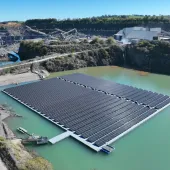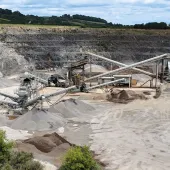E&JW Glendinning choose VEGA Contactless Radar Level Sensor

First published in the August 2015 issue of Quarry Management as Touching Base
E&JW Glendinning find new high-frequency contactless radar level sensor from VEGA reaches parts of their plant that others cannot
E&JW Glendinning, the largest independent suppliers of quarry and concrete products both to the trade and direct to the end-user in Devon and Cornwall, are still wholly owned by the founders’ families and many family members remain actively involved in the day-to-day running of the business – reflecting their belief in self-reliance and independence. Over recent years, the company has embarked upon an expansive programme of modernization and automation, creating a state-of-the-art aggregates processing and supply facility which is essential both to their business goals and to compete in the modern-day aggregates market.
As part of this programme, Glendinning require high-tech sensor solutions to deliver the automation and control philosophy they are seeking. The company makes high demands on equipment to get the best performance out of the plant, and the secondary crusher at the heart of the screening and grading plant in the quarry is typical of this requirement. The feed hopper above this crusher is a critical process control point, as this is where the majority of aggregate material passes through at some stage. It is a noisy, dusty environment, with unpredictable flow patterns and material behaviours.
The crusher itself is capable of processing up to 400 tonnes/h and the whole plant up to 4,000 tonnes a day. With this level of throughput, it is vitally important to have accurate information and control in order to optimize productivity, energy consumption and product quality from the crusher.
Originally, as is the case with many sites in the sector, non-contact ultrasonic level sensors were installed on the feed hopper. However, the noise, dust and product build-up regularly resulted in unreliable performance and a reduction in the level of control available. Instead of an analogue indication of the level in the hopper, it was more a case of step changes from low to high and back again; reflected echo signals would come and go, or they would ‘fail safe high’ through loss of echo.
This single measurement problem resulted in regular production stoppages, poor process control and energy management, and regular resets of the sensors to clear the problem. The ultrasonic units required regular maintenance (cleaning of the transducers, angle adjustments, tweaking of the software etc) in an effort to make them perform as the company wanted.
In a bid to improve the performance of the plant, Glendinning’s engineers turned to VEGA to trial one of their new VEGAPULS 69 radar level sensors in this problematic but highly critical control point. In detail, the application consists of a feed hopper measuring more than 8m in height and around 5m square at the bottom, with two sides sloping down to a central crusher feed. The hopper is fed by three different conveyors, either individually or simultaneously, and the feed size can range from dust up to 250mm, as the majority of material comes from the primary crushing plant.
Inside the feed hopper, a heavy build-up of stone on the ‘shoulders’ of the coned section results in the formation of a narrower ‘rat hole’ to the bottom. This material rarely moves, so it was important for the sensor to be able reliably to read down past this point.
The VEGAPULS 69 was installed in the existing mounting position of the ultrasonic sensor, very close to the main feed into the bunker. It was commissioned via a plug-in programmer on the top of the device. As soon as it was installed on the empty silo, and without any additional adjustment, the sensor was able to read right down to the bottom of the bin to the outlet conveyor. After just a few minor tweaks to optimize the performance of the sensor and its output, the radar worked successfully without incident for more than three months, providing a smooth bin level output and allowing operators to effectively control crusher throughput and conveyor speeds. This was achieved without the need for any additional maintenance work and thus reduced the amount downtime caused by measurement problems – a first for this area of the process.
According to VEGA, the reason why is this radar so different is that the VEGAPULS 69 works with very highly focused 79GHz microwaves, not sound waves, to provide a very small beam angle (3.5°), and offers optimized sensor performance for solids handling. Combined with radar’s natural immunity to in-flight dust, filling noise and air turbulence, VEGA say it promises to be one of the most capable and versatile solids level sensors ever, and is already proving itself in a number of difficult applications very similar to this one, where previously unmeasurable applications are now being successfully resolved.
Glendinning’s site engineer commented: ‘We like VEGA sensors because as we install and fit them, they just get on with the job. We don’t have to keep going back to carry out minor tweaks. We also like the continuity of the programming system; it’s pretty much the same for the radar sensors as for the pressure transmitters which we use in other areas of the plant.
‘All that is needed to set up a sensor is the PLICSCOM display/programmer that simply slots on to the sensor housing and allows access to all of the information to get the device up and running quickly and easily. We only need one programmer unit for all devices and the similar menu structure means the familiarity of operation allows us to set up the sensors quickly without constantly having to refer to the operating manuals.’
E&JW Glendinning are now so confident of the radar devices’ performance that they have embarked upon a schedule of installing them across the plant, replacing their existing ultrasonic sensors. According to the company, standardizing on this non-contact level radar, which although a little more expensive to purchase for some applications, has quickly shown significant payback in terms of reduced maintenance and outages, and increased productivity. For more information visit: www.vega.com
- Subscribe to Quarry Management, the monthly journal for the mineral products industry, to read articles before they appear on Agg-Net.com






